How to Write a Welcome and an Introductory Speech
How to write an Introductory paragraph
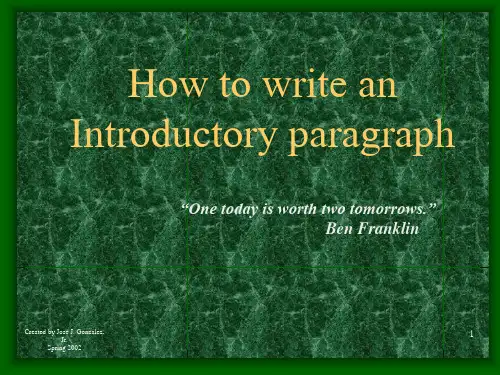
A question
8
• A recent article in Time magazine states that the
Quotation introduction
viewing of extremely violent television shows is the number one cause of violence in our inner cities. • The Monitor recently conducted a study and concluded that students in public schools where uniforms are mandatory have less problems and perform better academically. • A recent article in The Austin Statesman states that most Americans are very much against flag burning in public and are in favor of passing a law banning this activity.
greeting someone. The paragraph should be short and to the point like saying, “Hello!”
• Also, you don’t want to get into the meat of
the essay. Simply give the audience a concise idea of your essay’s purpose.
Created by JoséJ. Gonzá lez, Jr. Spring 2002
How to Write an Introduction
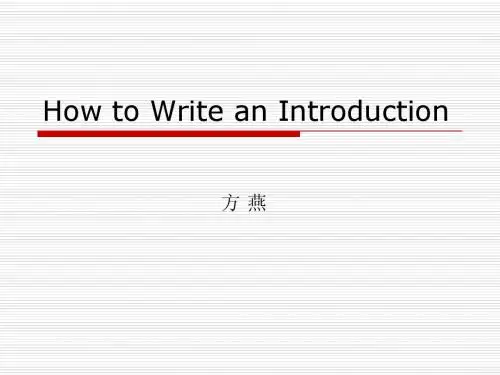
方燕
定义What is it for?
引言其实是全文最难写的—部分; 学术论文中的引言是对全文内容和结构的总 体勾画;
The part that states the reason and purpose P163
What does it contain?引言的内容 1
包括以下五项内容中的全部或其中几项: 介绍某研究领域的背景、意义、发展状况、 目前的水平等; 对相关领域的文献进行回顾和综述,包括前 人的研究成果,已经解决的问题,并适当加 以评价或比较;
引言的内容 2
指出前人尚未解决的问题,留下的技术空白, 也可以提出新问题、解决这些新问题的新方 法、新思路,从而引出自己研究课题的动机 与意义;
Layout引言的结构布局模式之二
第一层: Introducing the importance of the research area and reviewing previous Research…………………………………….… 第二层: Indicating the problem that has not been solved by previous research, raising a relevant question …………………………………………
句型4: Recently, there has been growing interest in / concern about + 研究主题 In the 1990s there has been growing interest in the development of electric vehicles in response to the public demand for cleaner air.
How_to_Write_the___Introduction
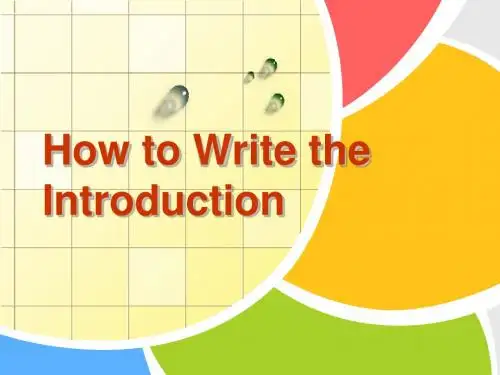
How do we solve the problem?
When do we write the introduction?
Many books recommend writing your introduction last, after you finish your project. This is to make sure that you introduce what you are actually going to say.
Simple Future Tense
Sometimes, in the sentence including the objective of the research, Simple Future Tense is recommended.
e.g. “In summary, previous methods are all extremely inefficient. Hence a new approach is developed to process the data more efficiently.“The later sentence should be — “In this paper, a new approach will be developed to process the data more efficiently” or “This paper will present a new approach that process the data more efficiently”.
Highlight Your Study Properly
Be sure your readers are convinced of the importance of your question, but don’t overdo it. e.g. In a paper on whether vitamin D will prevent osteoporosis, you need not to explain what osteoporosis and vitamin D are. You might, however, need to give them a sense of the scale of the problem, by including prevalence figures for osteoporosis, data on hospital admissions related to osteoporosis and so on.
how-to-write-an-introduction 引言
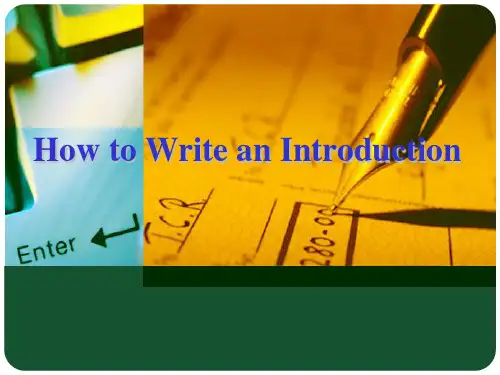
-4-
Writing an Introduction
1
What is it? Why do it? When do I do it? How do I do it?
How to write an introduction -5-
2
3
4
1.What is it ?
An introduction is the first paragraph of a written research paper. It has two parts:
How to write an introduction
-14-
-3-
The function of an introduction
serve as justification (an explanation of why your argument is even important in the first place).
How to write an introduction
How to write an introduction
-9-
4. How do I do it?
Start with a couple of sentences that introduce your topic to your reader. You do not have to give too much detailed information; save that for the body of your paper. Make these sentences as interesting as you can. Through them, you can hook a reader and get them very interested in the line of thinking you are going to develop in your project.
How to write an introduction
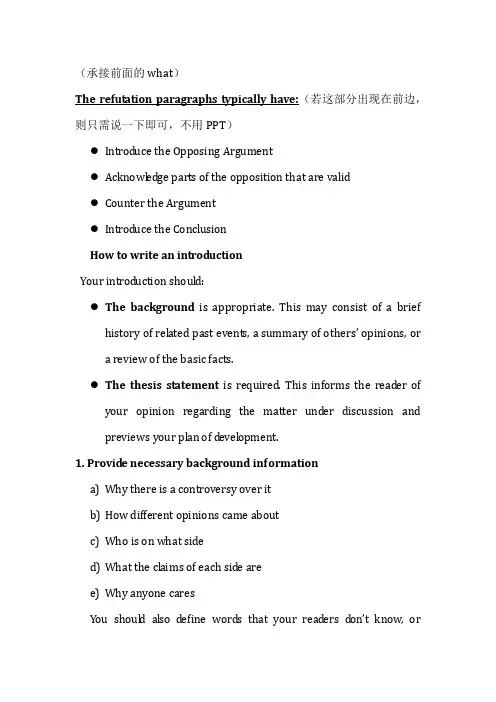
(承接前面的what)The refutation paragraphs typically have:(若这部分出现在前边,则只需说一下即可,不用PPT)●Introduce the Opposing Argument●Acknowledge parts of the opposition that are valid●Counter the Argument●Introduce the ConclusionHow to write an introductionYour introduction shoul d:●The background is appropriate. This may consist of a briefhistory of related past events, a summary of others’ opinions, ora review of the basic facts.●The thesis statement is required. This informs the read er ofyour opinion regarding the matter und er discussion and previews your plan of development.1. Provide necessary background informationa)Why there is a controversy over itb)How different opinions came aboutc)Who is on what sided)What the claims of each side aree)Why anyone caresYou should also define words that your read ers don’t know, orwords that usually general, but you use in a specific way, or words that are easily misund erstood in meaning.2. Be charmingYou can win the attention and good will of your readers by telling an interesting story, quoting a well-phrased comment on the issue. You should avoid pomposity(自负) and show concern for your readers. You should present yourself as fair-minded andgood-natured. (比如最近闹得沸沸扬扬的复旦投毒案,引起读者兴趣) Begin with signal words which alert the reader to the fact that the id eas you are presenting are not yours.●“While some supporters claim …”●“While those opposed to… argue …”●“It may be true that…”Example Introductory Paragraph: There has been much discussion about the use of nuclear power ever since the first reactor was built. People who support nuclear power think that it provides a cheap and effective means of supplying energy needs. However, in reality it is not cheap at all and the dangers are well-known after the accidents at Chernobyl and Three Mile Island. The fact is that nuclear power is a tried, tested and failed technology. Because of its cost, risk and alternatives, the buil ding of nuclear reactors should not continue.Example 2: It may be true that all such requests, in which dying patients ask doctors to help them to kill themselves, come from depression as some psychologists have claimed and that some patients will change their minds if they participate in psychotherapy. Example 3: “Are native English speakers the best English teachers?”(如果是反驳No的)The refutation paragraph might begin: “Those who do not think that native speakers are the best teachers claim that anyone who has learned a language as a chil d cannot und erstand the difficulties in l earning it. Native speakers may know how to speak the language, but they do not und erstand the grammar very well. However…”——followed by reasons not to be swayed by this argument complete with supporting details and explanations as need ed.(如果是反驳Yes的)The refutation paragraph might begin: “Some supporters of the notion that native speakers are the best English teachers claim that most fluent and natural use of language can be provided as model for learners. This may be true, but interest and passion for teaching should be taken into the first account…”Example 4: Some people claimed that there is no real alternative to a new generation of nuclear reactors. However, combined heat and power units, which generate electricity, are already economical for large houses or blocks of flats and small er units will be on the marketnext year. Local generation of electricity eliminates the enormous losses of wasted heat in electricity generation by fossil fuels or nuclear reactors. Wind turbines and solar cells on the roof can also provide home solutions and will become more economical as costs come down with mass production.a) Introduce the counter-argument. Helpful phrase:●There are people who believe… and they may think that•…●The writer states tha t…●Some people may feel that …●Supporters of [this issue] claim that…●Opponents of [this issue] insist that…●Not everyone agrees with this view, some would argue…●There are other sid es to this debate, including the perspectivethat…●On the other hand, …b) Afterwards, come back to your own argument. Here are some phrases you can use●However, I think that it is more important to consider …because…●Despite these arguments, I still think…because●The writer’s point has some validity, but…●It is true that…;however,…●Some people may feel that…,but I disagree because…●I believe, in contrast, that…●Nevertheless, it is argued that…●Nevertheless, some critics argue, …。
从自我介绍到正文,一篇完整的英文演讲稿该包含哪些要点
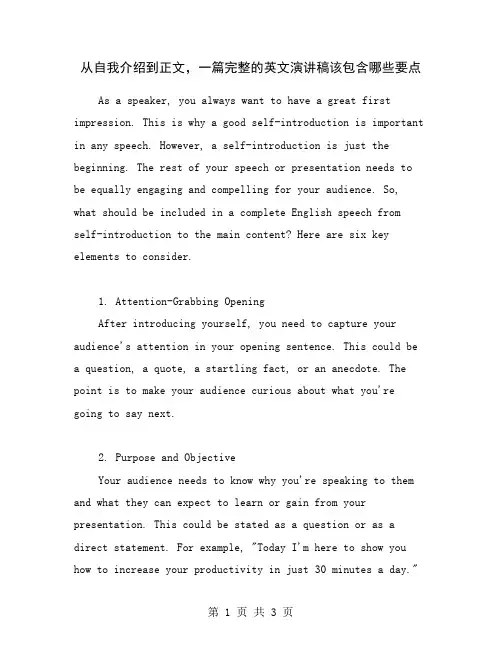
从自我介绍到正文,一篇完整的英文演讲稿该包含哪些要点As a speaker, you always want to have a great first impression. This is why a good self-introduction is important in any speech. However, a self-introduction is just the beginning. The rest of your speech or presentation needs to be equally engaging and compelling for your audience. So, what should be included in a complete English speech fromself-introduction to the main content? Here are six key elements to consider.1. Attention-Grabbing OpeningAfter introducing yourself, you need to capture your audience's attention in your opening sentence. This could be a question, a quote, a startling fact, or an anecdote. The point is to make your audience curious about what you're going to say next.2. Purpose and ObjectiveYour audience needs to know why you're speaking to them and what they can expect to learn or gain from your presentation. This could be stated as a question or as a direct statement. For example, "Today I'm here to show you how to increase your productivity in just 30 minutes a day."3. Outline of the Main PointsAfter stating your purpose, it's helpful for you to provide an outline of the main points you'll be discussing. This gives your audience a clear structure to follow and it makes it easier for them to follow along. State each point briefly and concisely.4. Supporting EvidenceTo make your speech convincing, you need to include supporting evidence such as examples, statistics, studies,and stories. This will help to reinforce your main points and make them more memorable. Use visuals to help your audience connect with your information. You can use a PowerPoint with relevant images, videos or graphs that made the point clearer.5. Engagement and InteractionIt's also important to keep your audience engaged and interested during your presentation. You can do this byasking rhetorical questions, telling stories, using humor,and involving your audience in your presentation. They cangive you feedback, or you can even run a quiz into your presentation to awaken their curiosity.6. ClosingAt the end of your presentation, you need to provide a clear and impactful conclusion. Summarize the main points of your presentation, restate your objective, and provide acall-to-action. For example, "Now that you know how toincrease your productivity, I want you to take action todayby using the tips I've shared with you."In conclusion, a complete English speech from self-introduction to the main content needs to have an attention-grabbing opening, a purpose and objective, an outline of the main points, supporting evidence, engagement, and interaction, as well as a strong closing. By incorporating all of these elements, you're sure to deliver a powerful and effective speech.。
How to write an Introductory paragraph
• Also, you don’t want to get into the meat of
the essay. Simply give the audience a concise idea of your essay’s purpose.
Created by JoséJ. Gonzá lez, Jr. Spring 2002
2
Remember that the introductory paragraph . . .
• Is the most important paragraph of the
essay • Must be at least 50 words long or three sentences minimum • Needs to do three things
Spring 2002
A question
8
• A recent article in Time magazine states that the
Quotation introduction
viewing of extremely violent television shows is the number one cause of violence in our inner cities. • The Monitor recently conducted a study and concluded that students in public schools where uniforms are mandatory have less problems and perform better academically. • A recent article in The Austin Statesman states that most Americans are very much against flag burning in public and are in favor of passing a law banning this activity.
1Unit 1 How to Write an Introduction
2
SCIENCE RESEARCH WRITING
ABSTRACT
INTRODwhat you did/used) central report section RESULTS (what you found/saw)
DISCUSSION/ CONCLUSION
4
SCIENCE RESEARCH WRITING
1.2 Grammar and Writing Skills This section deals with four language areas which are important in the Introduction: TENSE PAIRS SIGNALLING LANGUAGE PASSIVE/ACTIVE USE PARAGRAPHING 1.2.1 Tense pairs Present Simple/Present Continuous In order to use tenses correctly in the Introduction, you first need to look at the difference between the way the Present Simple tense and the Present Continuous tense are used. Look at these two sentences:
The synthesis of flexible polymer blends from polylactide and rubber
Introduction 1 Polylactide (PLA) has received much attention in recent years due to its biodegradable properties, which offer important economic benefits. 2 PLA is a polymer obtained from corn and is produced by the polymerisation of lactide. 3 It has many possible uses in the biomedical field1 and has also been investigated as a potential engineering material.2,3 4 However, it has been found to be too weak under impact to be used commercially.4 5 One way to toughen polymers is to incorporate a layer of rubber particles5 and there has been extensive research regarding the rubber modification of PLA. 6 For example, Penney et al. showed that PLA composites could be prepared using blending techniques6 and more recently, Hillier established the toughness of such composites.7 7 However, although the effect of the rubber particles on the mechanical properties of copolymer systems was demonstrated over two years ago,8 little attention has been paid to the selection of an appropriate rubber component. 8 The present paper presents a set of criteria for selecting such a component. 9 On the basis of these criteria it then describes the preparation of a set of polymer blends using PLA and a hydrocarbon rubber (PI). 10 This combination of two mechanistically distinct polymerisations formed a novel copolymer in which the incorporation of PI significantly increased flexibility.
高一必修一英语welcomeunit作文
高一必修一英语welcomeunit作文全文共3篇示例,供读者参考篇1Welcome to the first unit of Welcome to English class. In this unit, we will explore various topics related to greetings, introductions, and basic communication skills. Learning English is a journey that requires patience, dedication, and practice. So let's get started!In this unit, you will learn how to greet someone in different situations, such as meeting a friend, a colleague, or a stranger. You will also learn how to introduce yourself and others, and how to ask basic questions to start a conversation. These skills are essential for everyday communication and will help you build stronger relationships with others.Additionally, you will learn about some common expressions and phrases used in English, such as "How are you?" "Nice to meet you," and "What's your name?" These phrases will help you navigate social interactions and make a good impression on others.Throughout this unit, we will focus on practicing speaking, listening, reading, and writing skills. You will have the opportunity to engage in conversations with your classmates, listen to native speakers, read short texts, and write simple sentences and paragraphs. By practicing these skills regularly, you will improve your English proficiency and become more confident in using the language.I encourage you to participate actively in class, ask questions, and make mistakes. Learning a new language can be challenging, but it is also a rewarding experience that opens up new opportunities and expands your horizons. So let's embrace the challenge and enjoy the journey of learning English together!I look forward to seeing your progress throughout this unit and am here to support you every step of the way. Welcome to English class, and let's have a great time learning together!篇2Welcome to Unit 1 of your first year of high school! In this unit, we will be exploring various topics in English that will help you build a strong foundation for your language learning journey.First and foremost, I would like to congratulate you on taking this important step in your education. High school is a time for growth, discovery, and learning, and I am excited to be a part of your journey.In this unit, we will be focusing on basic grammar concepts, vocabulary building, and reading comprehension skills. These are essential skills that will serve as the building blocks for your future language learning endeavors. By mastering these fundamentals, you will be better equipped to tackle more advanced topics in English in the years to come.One of the key aspects of this unit is grammar. Grammar is the backbone of any language, and mastering its rules and structures will help you communicate effectively and clearly. Throughout this unit, we will be going over important grammar concepts such as verb tenses, sentence structure, and punctuation rules. By understanding and practicing these concepts, you will be able to communicate your thoughts and ideas with precision and clarity.In addition to grammar, we will also be focusing on vocabulary building. Vocabulary is essential for expressing yourself in English, as the words you use can greatly impact the message you are trying to convey. In this unit, we will be learningnew words and phrases, as well as strategies for expanding your vocabulary on your own. By broadening your vocabulary, you will be able to express yourself more creatively and accurately in English.Lastly, we will be working on reading comprehension skills. Reading is a valuable skill that not only helps improve your language proficiency, but also broadens your knowledge and understanding of the world. In this unit, we will be reading various texts, analyzing their main ideas, and identifying key details. By honing your reading comprehension skills, you will be able to better understand and engage with a wide range of texts in English.In conclusion, I want to welcome you to this exciting new chapter in your academic journey. I am confident that by working hard and staying committed to your studies, you will make great strides in your English language learning. Remember, each step you take in mastering English brings you closer to fluency and proficiency. I am here to support and guide you every step of the way. Good luck, and let's make this unit a successful and rewarding experience together!篇3Welcome to High School!Dear new students,Welcome to high school! We are thrilled to have you join us for this exciting chapter in your academic journey. The transition from middle school to high school can be challenging, but we are here to support you every step of the way.In this first unit of the English curriculum, we will focus on building a strong foundation in reading, writing, speaking, and listening skills. This unit will provide you with the necessary tools to succeed in all aspects of your English studies throughout the year.Reading is an essential skill that will help you explore new ideas, cultures, and perspectives. By reading a variety of texts, you will expand your vocabulary and improve your comprehension skills. Through active reading and annotation, you will learn to analyze texts critically and extract key information.Writing is another crucial skill that you will develop in this unit. Whether you are crafting essays, reports, or creative pieces, effective writing requires organization, clarity, and creativity.Through practice and feedback, you will enhance your ability to express yourself clearly and persuasively.Speaking and listening skills are equally important in English language learning. In this unit, you will have the opportunity to engage in class discussions, group activities, and presentations. These activities will help you become more confident and articulate speakers, as well as attentive listeners.As you begin this new academic journey, remember that mistakes are a natural part of the learning process. Don't be afraid to take risks, ask questions, and seek help when needed. Your teachers are here to support you and guide you towards success.We are excited to see the growth and progress you will make throughout the year. Together, we will create a positive and engaging learning environment where you can thrive and achieve your academic goals.Welcome to high school, and best of luck in this new chapter of your life!Sincerely,The English Department。
How_to_write_an_Introduction
•a personal insight or experience
The Introduction
Next: start narrowing your focus to a TOPIC SENTENCE: You state what your topic is and what your opinion on the topic will be.
However, if you can convey the structure of your essay without using too many organizational words, that is even better.
Discussion of first example
Introduction
3. Proper acknowledgement of the previous work on which you are building. Sufficient references such that a reader could, by going to the library, achieve a sophisticated understanding of the context and significance of the question. 4. Explain the scope of your work, what will and will not be included.
But let us review it to see if it can be improved.
Discussion of first example
ห้องสมุดไป่ตู้
- 1、下载文档前请自行甄别文档内容的完整性,平台不提供额外的编辑、内容补充、找答案等附加服务。
- 2、"仅部分预览"的文档,不可在线预览部分如存在完整性等问题,可反馈申请退款(可完整预览的文档不适用该条件!)。
- 3、如文档侵犯您的权益,请联系客服反馈,我们会尽快为您处理(人工客服工作时间:9:00-18:30)。
How to Write a Welcoming Speech
Welcome speech
End-a warm welcome again
Begin-welcome
Body-a brief introduction of the guests and the purpose of the visit
How to Write a Welcoming Speech
• What should we know?
• Understand the speech's purpose and how much time you have to deliver it. • Greet the attendees at the beginning of the speech and welcome them to the event. • Tell the attendees why they should be interested or excited to be at the event.
How to Write a Welcome and an Introductory Speech
Group 3 Jiang Han
How to Write a Welcoming Speech
• What is welcoming speech?
It's delivered to mark the beginning of an event or occasion. eg.conference,seminar,or course.
How to Write a Welcoming Speech
• What's the objective of a welcoming speech?
The objective is to 1.greet the audience, 2.explain why the event is so exciting and interesting, 3.set the tone for the event, rm the audience of what to expect.
How to Writ What should we do?
• Ask for a copy of his bio or gather any information you can on the events that lead up to this point in his life. • Even if you've known him for years,chances are that you do not know by heart the precise timeline of milestones in his life.
How to Write an Introductory Speech
Useful Expressions:
It is my honor to introduce... I now have the pleasure of introducing to you the first distinguished speaker... The next speaker is Mr.Bryan,who will now deliver his address to the conference.
How to Write an Introductory Speech
• What should we know?
• Why you're being asked to give an introductory speech for this person. • What is the event. • What is he/she planning to talk about after introduction.
How to Write a Welcoming Speech
• What should we do?
• Provide an overview of what will occur at the event. • Introduce other speakers or key players in the event,such as the event's planners or sponsors. • Express hopes for the event and the attendees' enjoyment of it. • Conclude by thanking the audience for attending.
